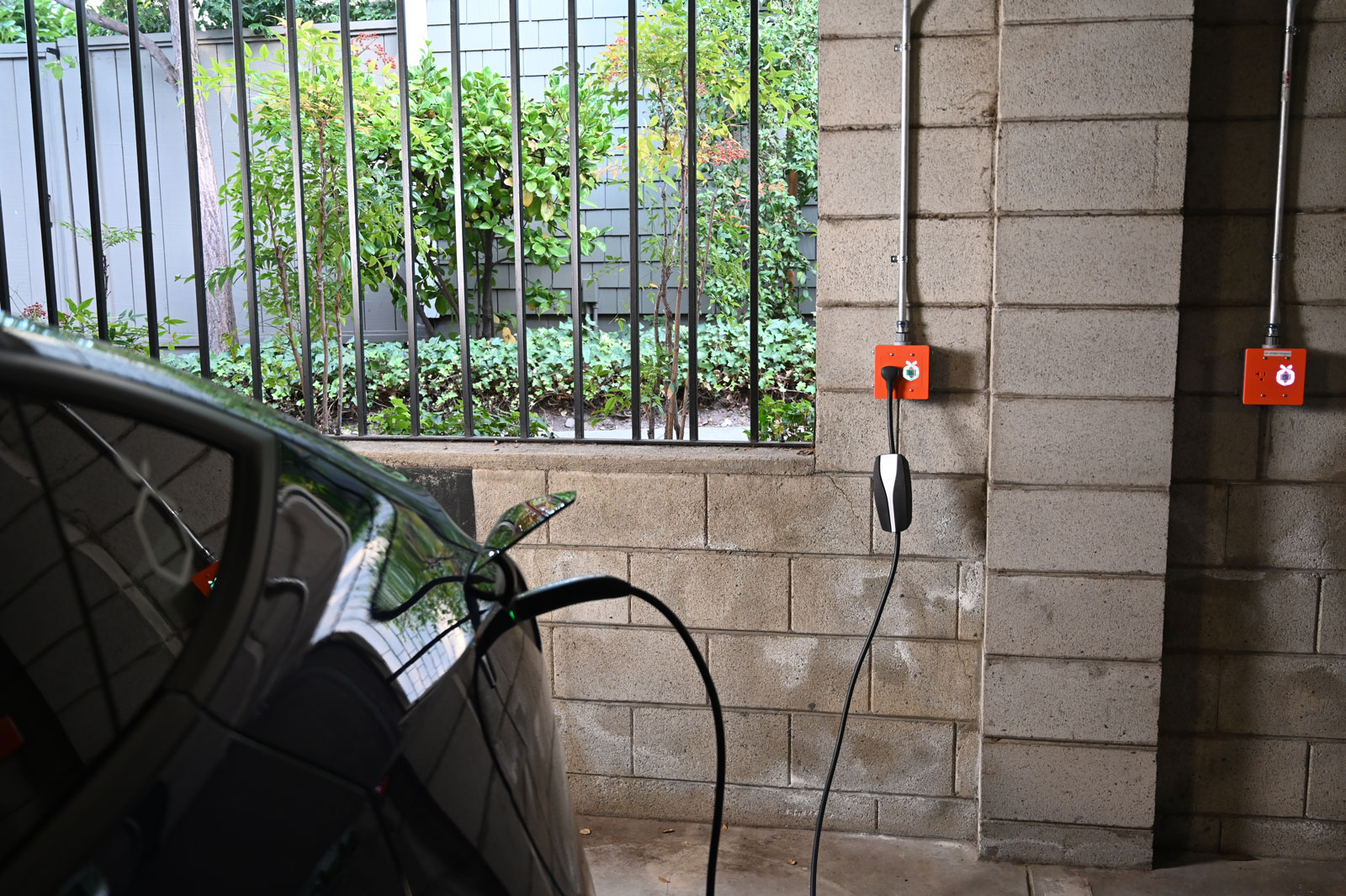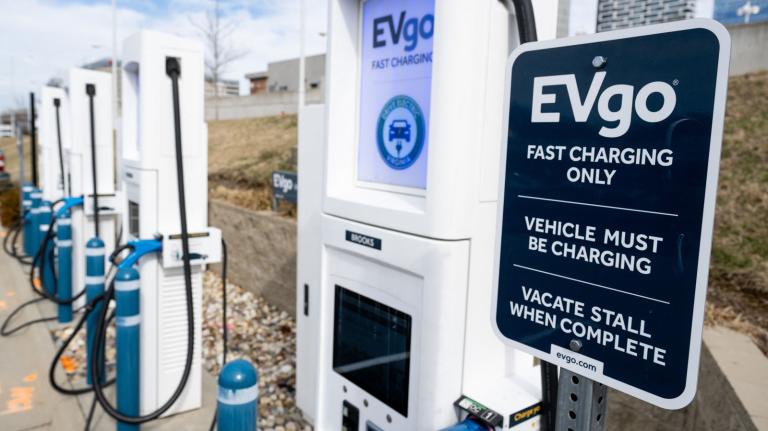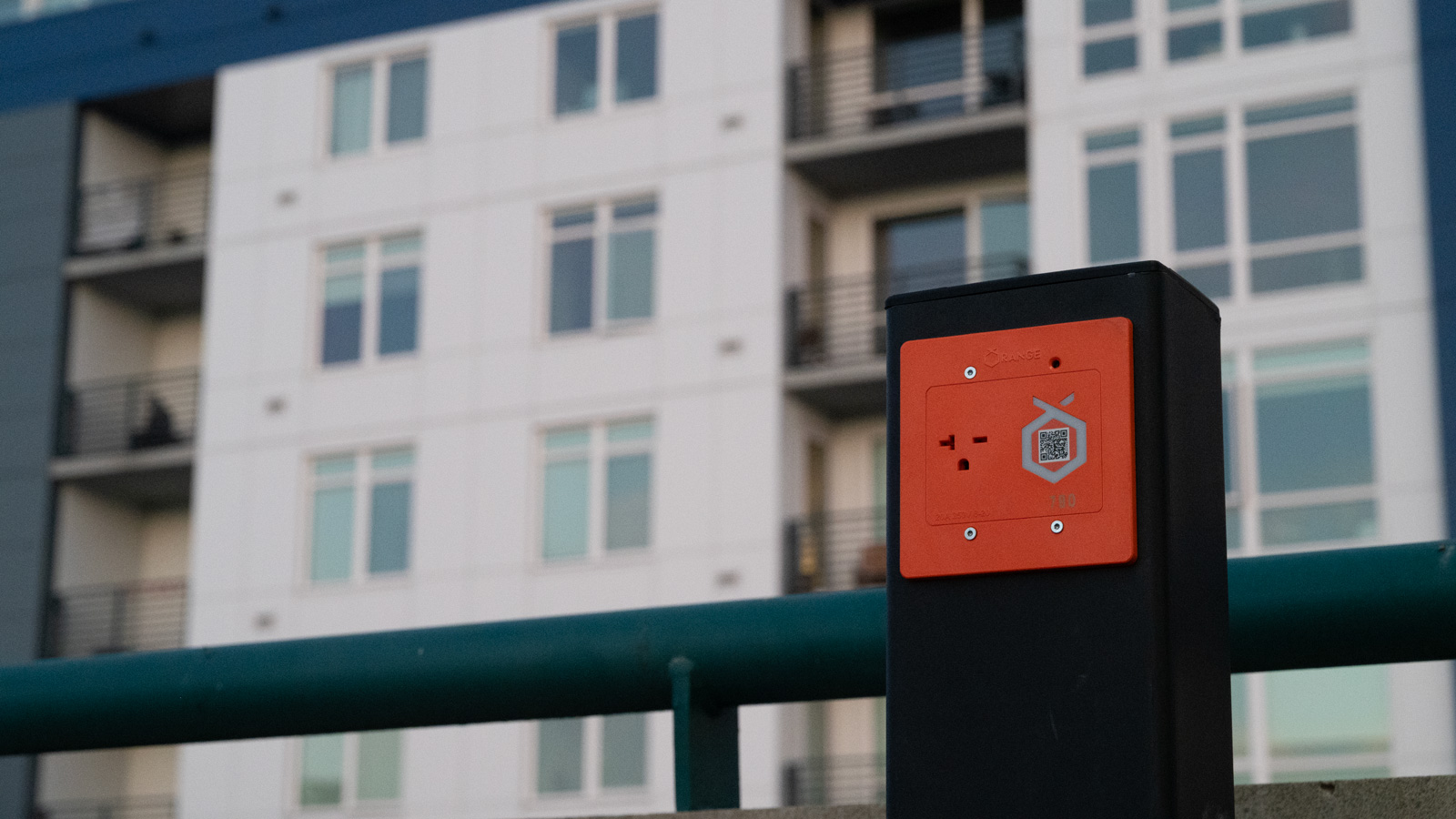Kay and Bruce Schilling decided last year that they wanted to install electric vehicle charging at an apartment building they manage in Belmont, California, but they had no idea where to begin.
They figured that adding the amenity could attract renters, and Kay so loved driving her own EV that she hoped providing chargers would help tenants make the switch themselves. “Once people experience driving an electric car, it’s like you can never turn back,” she said.
The Schillings considered their options. DC fast chargers can top off a battery in as little as 30 minutes, but were far too expensive. They looked into Level 2 chargers — like those commonly seen outside grocery stores and office buildings that typically charge a car in four to ten hours — and quickly encountered challenges.
To supply enough power, they’d need an expensive electrical upgrade, which could take at least a year due to long permitting queues. The required improvements and charging hardware were so costly that they’d only be able to install a couple chargers, requiring tenants to share. And since a powerful Level 2 could fill an EV battery in a few hours, residents would have to move their cars when they were finished to open the stall for the next driver.
“It didn’t feel like a very friendly way to provide a service to our tenants,” Kay told Grist.
Then the Schillings heard about a program by the community-led electricity provider Peninsula Clean Energy, or PCE, aimed at getting apartment building owners to adopt a commonly dismissed method of EV fueling: Level 1 charging, done with a trusty wall outlet.
Level 1 charging is slow: It uses a 120-volt outlet, like a TV would, and batteries fill at a rate of about five miles every hour. But it’s also relatively cheap and simple. The Schillings discovered they could install 30 Level 1 “smart” outlets — one for almost every parking stall — without major electrical work. PCE picked up nearly the entire bill.

While most EV drivers who own a single-family home can install a charger, the one-third of the U.S. population living in multifamily dwellings depend on property owners to make that decision. But those who want to provide the amenity often encounter infrastructure hurdles, prohibitive costs, and the conundrum of how to implement a system that is convenient for tenants.
It’s a problem that the U.S. is only beginning to confront, since most early EV adopters live in single-family houses. That will soon change, according to Brennan Borlaug, a research analyst at the National Renewable Energy Laboratory, or NREL, who co-authored a study on national charging needs.
“We’re coming into a period where the used EV market is going to start to be flooded and there are going to be a lot of people adopting EVs in multifamily homes,” Borlaug said. “It’s going to be exciting to see more people be able to drive these cars, but there will be some growing pains.”
To support 33 million electric vehicles on U.S. roads by 2030, NREL estimates the U.S. would need nearly 27 million Level 1 and 2 charging ports at residences and workplaces. Reaching that number will require an enormous effort, but PCE believes one tool for getting there is to “right size” charging solutions, putting less focus on speed and more emphasis on ubiquity.
PCE is a community choice aggregator that sources clean energy for residents of San Mateo County just south of San Francisco, where EVs accounted for one-third of new car registrations last year and around 250,000 residents live in multifamily dwellings. It is focusing millions of dollars on incentives for Level 1 charging. The strategy, it says, will get more people some power instead of a few people a lot of power.
“Using low-power solutions seems to be the fastest, most affordable, and most scalable solution to get immediate charging access to where people live,” Phillip Kobernick, head of transportation programs at PCE, told Grist. “So instead of putting one [fast] charger in, which is the default way, let’s put in 20, and at a much lower cost.”
Through its EV Ready program, PCE has already spent over $2 million to help install nearly 1,000 charge ports, most of them at apartment buildings and condos. Another 3,000 are in process.
To craft its strategy, PCE scoured census data and surveyed customers. It discovered that most drivers leave their cars parked for at least 12 hours a day, and don’t drive more than about 40 miles daily. It also found that those customers who did use Level 2 charging at their apartments were plugged in all night, but drawing electricity for less than three hours.
“That was like, okay, obviously this is an overbuilt solution,” said Kobernick, “if you’re just sitting there with a plug in your car doing nothing for nine hours.”
The long periods that cars were parked at night, and the short distances they were driving in the day, meant that plugging into a standard outlet could easily keep drivers’ batteries topped off. “It’s not that we reinvented the wheel,” said Kobernick. “It’s more that we matched our program to do what a lot of people are already doing.”
The low-and-slow approach also meant far fewer buildings would need electrical upgrades, and it would put less pressure on California’s already strained grid. But the strategy would only work if the outlets were installed in high volumes so every tenant could access one and plug in for as long as necessary. PCE created a program that would pay up to $2,000 per Level 1 or “low-power” Level 2 outlet (which uses a 240-volt, 20-amp outlet and can add about 140 miles overnight), with no cap on the number of outlets. The subsidies are higher for affordable housing buildings, and all projects include free site design.
The Schillings’ project at the El Dorado Apartments took just two weeks to permit and two more to install. They needed a couple of panel upgrades, but nowhere near the amount of work required if they’d chosen Level 2 hardware. With PCE’s help, the $77,000 undertaking cost them just $12,000.
Residents plug in to the Orange Level 1 “smart” outlets with the cord that comes with their car, and pay for the electricity through a connected app. The Schillings said their tenants have embraced the approach.
“You just kind of plug in and forget it,” said Bruce. “It’s good for the night.” Not long after the outlets were installed, a resident told them that now that he could charge at home, he was going to buy an EV.
There’s a public fast charging station across the street from the El Dorado Apartments, which tenants can use if they need to fill up quickly for a long day of driving. Borlaug said that this kind of symbiotic relationship helps the Level 1 approach work while taking pressure off the fast chargers, which are, for now, underbuilt and oversubscribed.
“Level one is get what you can, and then you rely on the public networks to backfill whenever you need it,” he said.

By reducing reliance on public charging, which typically costs more than filling up at home, PCE’s approach could widen EV access, too.
The St. Francis Center, which manages affordable housing units in San Mateo County, used PCE rebates to install smart outlets in six parking stalls at the Alma Lea apartments in Redwood City. There are no EV drivers there yet, but the center wanted to make sure that a lack of home charging wouldn’t stand in the way of anyone considering switching to electric.
“It’s thinking about the lived experience of our tenants long term and setting them up for success,” said Michael Pierce, board chairman of the St. Francis Center. “The families in our properties should have the opportunity to own an electric vehicle and get the benefits of lower cost per mile and less maintenance.”
Pierce believes that now that the outlets are there, it’s only a matter of time before electric vehicles appear in the parking lot. “I think it’s a chicken-and-egg thing. When they need another car, it’s an option that they can choose without having to worry about charging.”
Some additional features of the GoPowerEV PowerPort outlets, capable of both Level 1 charging and low-power Level 2, could save Alma Lea’s tenants even more money on charging costs. Drivers set how many miles they need to add to their range and what time they need it through the connected app, and the software can wait to charge the car until electricity rates are cheapest. Users can even tell the app to charge only during the least expensive times, even if that means not getting as many miles as filling up the whole time the car is plugged in.
That option works, Pierce says, because drivers are charging every time they park, rather than whenever they manage to find a spot at a public fast-charging station. “You realize, I don’t need to do this binary ‘full, not full,’” he said. “I can just add a little bit at a time and I’m going to be fine.”
This story has been updated to reflect the cost of the El Dorado Apartment project.



